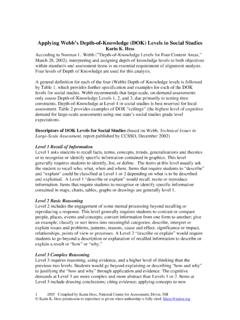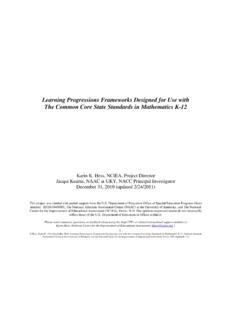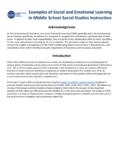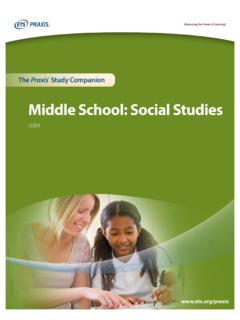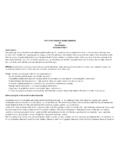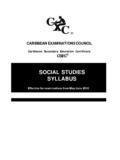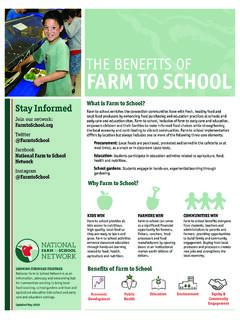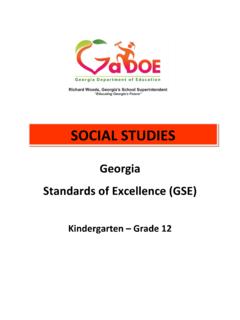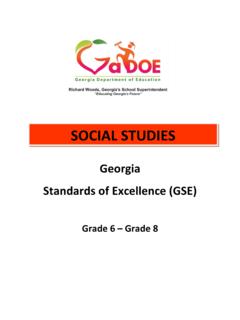Transcription of Applying Webb’s Depth-of-Knowledge (DOK) Levels in Social ...
1 Applying Webb s Depth-of-Knowledge (DOK) Levels in Social studies Karin K. Hess According to Norman L. Webb ( Depth-of-Knowledge Levels for Four Content Areas, March 28, 2002), interpreting and assigning Depth-of-Knowledge Levels to both objectives within standards and assessment items is an essential requirement of alignment analysis. Four Levels of Depth of Knowledge are used for this analysis. A general definition for each of the four (Webb) Depth-of-Knowledge Levels is followed by Table 1, which provides further specification and examples for each of the DOK Levels for Social studies .
2 Webb recommends that large-scale, on-demand assessments only assess Depth-of-Knowledge Levels 1, 2, and 3, due primarily to testing time constraints. Depth-of-Knowledge at Level 4 in Social studies is best reserved for local assessment. Table 2 provides examples of DOK ceilings (the highest level of cognitive demand for large-scale assessment) using one state s Social studies grade level expectations. Descriptors of DOK Levels for Social studies (based on Webb, Technical Issues in Large-Scale Assessment, report published by CCSSO, December 2002) Level 1 Recall of Information Level 1 asks students to recall facts, terms, concepts, trends, generalizations and theories or to recognize or identify specific information contained in graphics.
3 This level generally requires students to identify, list, or define. The items at this level usually ask the student to recall who, what, when and where. Items that require students to describe and explain could be classified at Level 1 or 2 depending on what is to be described and explained. A Level 1 describe or explain would recall, recite or reproduce information. Items that require students to recognize or identify specific information contained in maps, charts, tables, graphs or drawings are generally level 1. Level 2 Basic Reasoning Level 2 includes the engagement of some mental processing beyond recalling or reproducing a response.
4 This level generally requires students to contrast or compare people, places, events and concepts; convert information from one form to another; give an example; classify or sort items into meaningful categories; describe, interpret or explain issues and problems, patterns, reasons, cause and effect, significance or impact, relationships, points of view or processes. A Level 2 describe or explain would require students to go beyond a description or explanation of recalled information to describe or explain a result or how or why. Level 3 Complex Reasoning Level 3 requires reasoning, using evidence, and a higher level of thinking than the previous two Levels .
5 Students would go beyond explaining or describing how and why to justifying the how and why through application and evidence. The cognitive demands at Level 3 are more complex and more abstract than Levels 1 or 2. Items at Level 3 include drawing conclusions; citing evidence; Applying concepts to new 1 2005 Complied by Karin Hess, National Center for Assessment, Dover, NH Karin K. Hess permission to reproduce is given when authorship is fully cited situations; using concepts to solve problems; analyzing similarities and differences in issues and problems; proposing and evaluating solutions to problems; recognizing and explaining misconceptions or making connections across time and place to explain a concept or big idea.
6 Level 4 Extended Reasoning Level 4 requires the complex reasoning of Level 3 with the addition of planning, investigating, or developing that will most likely require an extended period of time. The extended time period is not a distinguishing factor if the required work is only repetitive and does not require Applying significant conceptual understanding and higher-order thinking. At this level the cognitive demands should be high and the work should be very complex. Students should be required to connect and relate ideas and concepts within the content area or among content areas in order to be at this highest level.
7 The distinguishing factor for Level 4 would be evidence through a task or product that the cognitive demands have been met. A Level 4 performance will require students to analyze and synthesize information from multiple sources, examine and explain alternative perspectives across a variety of sources and/or describe and illustrate how common themes and concepts are found across time and place. In some Level 4 performance students will make predictions with evidence as support, develop a logical argument, or plan and develop solutions to problems. Many on-demand assessment instruments will not include assessment activities that could be classified as Level 4.
8 However, standards, goals, and objectives can be stated so as to expect students to perform thinking at this level. On-demand assessments that do include tasks, products, or extended responses would be classified as Level 4 when the task or response requires evidence that the cognitive requirements have been met. Source of Challenge Criterion for Social studies The Source of Challenge criterion is only used to identify items where the major cognitive demand is inadvertently placed and is other than the targeted Social studies content, concept, skill and application. Excessive reading demands, cultural bias, or specialized knowledge could be reasons for an item to have a source of challenge problem.
9 Such item characteristics may cause some students to not answer an assessment item or answer an assessment item incorrectly even though they have the Social studies content knowledge, understanding and skills being assessed. Items with an appropriate source of challenge level will differentiate between those students who have the Social studies knowledge and understanding the assessment item intends to measure from those students who do not have this knowledge. 2 2005 Complied by Karin Hess, National Center for Assessment, Dover, NH Karin K. Hess permission to reproduce is given when authorship is fully cited Table 1: Sample Depth-of-Knowledge Level Descriptors for Social studies (Based on Webb, Karin Hess, 2005, National Center for Assessment ) Level 1 Recall of Information Level 2 Basic Reasoning Level 3 Complex Reasoning Level 4 Extended Reasoning a.
10 Explain, generalize, or connect ideas, using supporting evidence from a text/source a. Analyze and explain multiple perspectives or issues within or across time periods, events, or cultures a. Recall or recognition of: fact, term, concept, trend, generalization, event, or document b. Identify or describe features of places or people c. Identify key figures in a particular context meaning of words d. Describe or explain: who, what, where, when e. Identify specific information contained in maps, charts, tables, graphs, or drawings a. Describe cause-effect of particular events b. Describe or explain: how (relationships or results), why, points of view, processes, significance, or impact c.
